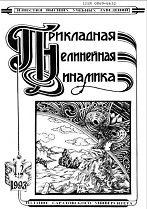|
NONLINEAR DYNAMICS AND NEUROSCIENCE
Working memory capacity: the role of parameters of spiking neural network model
N. S. Kovaleva, V. V. Matrosov, M. A. Mishchenko
National Research Lobachevsky State University of Nizhny Novgorod, Russia
Abstract:
Purpose of this work is to study a computational model of working memory formation based on spiking neural network with plastic connections and to study the capacity of working memory depending on the time scales of synaptic facilitation and depression and the background excitation of the network. Methods. The model imitates working memory formation within synaptic theory: memorized items are stored in form of short-term potentiated connections in selective population but not in form of persistent activity. Integrate-And-Fire neuron model in excitable mode are used as network elements. Connections between excitatory neurons demonstrates the effect of short-term plasticity. Results. It is shown that the working memory capacity increases as calcium recovery time parameter grow up or the capacity increases with neurotransmitter recovery time parameter becomes lower. Working memory capacity is found to decrease to zero with decrease of the background excitation as a result of lower values of both the mean and the variance of the external noise. Conclusion. Working memory capacity was studied as a function of time scales of synaptic facilitation and depression and background excitation of the network. Estimated working memory capacity is shown to be possibly larger than classical experimental estimations of four items. But capacity strongly depends on intrinsic parameters of neural networks.
Keywords:
working memory, memory capacity, spiking neural network, delayed activity, short-term synaptic plasticity.
Received: 31.08.2022
Citation:
N. S. Kovaleva, V. V. Matrosov, M. A. Mishchenko, “Working memory capacity: the role of parameters of spiking neural network model”, Izvestiya VUZ. Applied Nonlinear Dynamics, 31:1 (2023), 86–102
Linking options:
https://www.mathnet.ru/eng/ivp519 https://www.mathnet.ru/eng/ivp/v31/i1/p86
|

| Statistics & downloads: |
| Abstract page: | 119 | | Full-text PDF : | 30 | | References: | 14 |
|




 Contact us:
Contact us: Terms of Use
Terms of Use
 Registration to the website
Registration to the website Logotypes
Logotypes








 Citation in format
Citation in format 